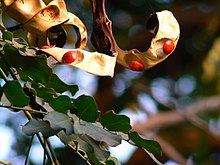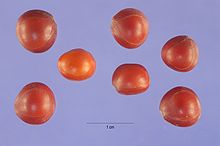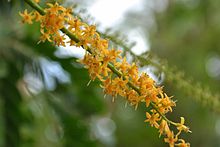Adenanthera pavonina is a perennial and non-climbing species of leguminous tree. Its uses include food and drink, traditional medicine, and timber.[3]
| Adenanthera pavonina | |
|---|---|

| |
| Adenanthera pavonina manjadi with red seeds, India | |
| Scientific classification | |
| Kingdom: | Plantae |
| Clade: | Tracheophytes |
| Clade: | Angiosperms |
| Clade: | Eudicots |
| Clade: | Rosids |
| Order: | Fabales |
| Family: | Fabaceae |
| Subfamily: | Caesalpinioideae |
| Clade: | Mimosoid clade |
| Genus: | Adenanthera |
| Species: | A. pavonina
|
| Binomial name | |
| Adenanthera pavonina | |


Common names
editCommon names for Adenanthera pavonina include Acacia coral, arbre À Église, bead tree, Circassian seed, corail végétal, coral wood, madhoshi, moralitos, curly bean, deleite, Delicia, dilmawi, Graine-réglisse, jumbi-bead, l'Église, peronías, Peonía, Peonía extranjera, piriquiti, red bead tree, and réglisse.[3] Barbados pride, peacock flower fence, sandalwood tree, saga, and manchadi are additional common names[4] In Kerala where Adenanthera pavonina trees are abundant, the seeds are called Manjadi (മഞ്ചാടി).[5]
Distribution
editThe tree is common within the tropics of the old world. It has also been introduced in the following countries of the Americas:
- Brazil, especially in Caatinga vegetation; Costa Rica, Honduras, Cuba, Jamaica, Puerto Rico, Trinidad, Tobago, Venezuela, and the United States, especially in southern Florida.
Uses
editThis tree is useful for nitrogen fixation, and it is often cultivated for forage, as an ornamental garden plant or urban tree, and as a medicinal plant. For example, the young leaves can be cooked and eaten. The raw seeds are toxic, but may be eaten when cooked.[6] In Singapore, the species forms part of the diet of local Raffles' banded langurs.[7]
Adenanthera pavonina seeds have long been a symbol of love in China, and its name in Chinese is xiang si dou (Chinese: 相思豆), or "mutual love bean". The beauty of the seeds has led to them being used as beads for jewellery. The botanist Edred Corner stated that in India, the seeds have been used as units of weight for fine measures, of gold for instance, throughout recorded history because the seeds are known to be almost identical weights to each other.[8] Indeed, the Malay name for the tree, saga,[9] has been traced to the Arabic for 'goldsmith'. The small, yellowish flower grows in dense drooping rat-tail flower heads, almost like catkins. The curved hanging pods, with a bulge opposite each seed, split open into two twisted halves to reveal the hard, scarlet seeds. This tree is used for making soap,[10] and a red dye can be obtained from the wood. The wood, which is extremely hard, is also used in boat-building, making furniture and for firewood.
The tree is fast-growing, with an attractive, spreading canopy that makes it suitable as a shade tree, and for ornamental purposes in large gardens or parks. However, it is also known for producing much litter in the form of leaves, twigs and especially seed pods which crack open while still on the branch, so releasing their seeds, before themselves falling to the ground.
In traditional medicine, a decoction of the young leaves and bark of Adenanthera pavonina is used to treat diarrhea.[11] Also, the ground seeds are used to treat inflammation.[12] Preliminary scientific studies appear to support these traditional uses. In vitro studies show that Adenanthera pavonina leaf extract has antibacterial activity against the intestinal pathogen Campylobacter jejuni.[13] Also, high doses of seed extract have an anti-inflammatory effect in studies in rats and mice.[14]
Chemical constituents
editAdenanthera pavonina is a source of aliphatic natural products (O-acetylethanolamine and 1-octacosanol), carbohydrate (galactitol), simple aromatic natural products (2,4-dihydroxybenzoic acid), flavonoids (ampelopsin, butein, dihydrorobinetin, and robinetin), terpenoids (echinocystic acid and oleanolic acid), steroids (daucosterol, β-sitosterol, and stigmasterol), amino acids and peptides (2-amino-4-ethylidenepentanedioic acid and γ-methyleneglutamine), and alkaloids (O-acetylethanolamine and 1H-imidazole).[3]
References
edit- ^ Barstow, M. (2019). "Adenanthera pavonina". IUCN Red List of Threatened Species. 2019: e.T18435896A18435900. doi:10.2305/IUCN.UK.2019-2.RLTS.T18435896A18435900.en. Retrieved 19 July 2024.
- ^ "Adenanthera pavonina L." Plants of the World Online. Royal Botanic Gardens, Kew. Retrieved 19 July 2024.
- ^ a b c Bisby F (1994). Phytochemical Dictionary of the Leguminosae, Volume 1. Chapman and Hall/CRC. pp. 53–54. ISBN 0-412-39770-6.
- ^ "Adenanthera pavonina". International Legume Database & Information Service. Archived from the original on 7 June 2015. Retrieved 8 March 2014.
- ^ "Red Bead Tree". Flowers of India. Archived from the original on 2014-11-10. Retrieved 1 December 2021.
- ^ J. H. Maiden (1889). The useful native plants of Australia : Including Tasmania. Turner and Henderson, Sydney.
- ^ Ang, Andie; Jabbar, Sabrina (2021). Raffles' Banded Langur: The Elusive Monkey Of Singapore And Malaysia. World Scientific. p. 55. ISBN 9789811241482.
- ^ Corner EJH (1988). Wayside Trees of Malaya, Volume 1. Malaysian Nature Society. ISBN 967-99906-0-5.
- ^ Simon Gardner, Pindar Sidisunthorn and Lai Ee May, 2011. Heritage Trees of Penang. Penang: Areca Books. ISBN 978-967-5719-06-6
- ^ "Species used for Soap". The Green Farmacy Garden. Archived from the original on 2015-09-23. Retrieved 8 March 2014.
- ^ "Adenanthera pavonina". International Center for Research in Agroforestry. Archived from the original on 27 September 2013. Retrieved 24 September 2013.
- ^ Smith AC (1985). Flora Vitiensis Nova: A New Flora of Fiji, Volume 5. National Tropical Botanical Garden. pp. 56–57.
- ^ Dholvitayakhun A; et al. (2012). "Antibacterial activity of three medicinal Thai plants against Campylobacter jejuni and other foodborne pathogens". Natural Product Research. 26 (4): 356–363. doi:10.1080/14786419.2010.545777. PMID 21878033. S2CID 24104416.
- ^ Olajide OA; et al. (2004). "Anti-inflammatory studies on Adenanthera pavonina seed extract". Inflammopharmacology. 12 (2): 196–202. doi:10.1163/1568560041352310. PMID 15265320. S2CID 13108237.
External links
edit- Media related to Adenanthera pavonina at Wikimedia Commons
- Adenanthera pavonina
- USDA Plants Profile: Adenanthera pavonina
- Adenanthera pavonina L. Medicinal Plant Images Database (School of Chinese Medicine, Hong Kong Baptist University) (in Chinese) (in English)
